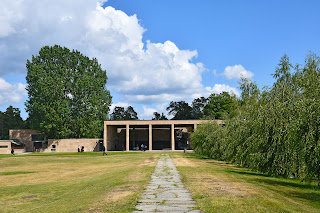Scandinavia Trip: Day 2 – Stockholm
Despite the practically incessant stream of light outside my window on this warm summer night, I managed to sleep until around seven. Rather than the sun, what woke me up was a persistent mechanical noise. My hotel here is on a boat, but I do not think that the sound was of a nautical origin – unlike the squeaking of wood, metal, and rubber that followed the movement of the waves.
I had a lot on my
itinerary for the day, so I decided to start out in the Old Town and work my
way towards other attractions. Crossing the bridge from
the island of Södermalm, I walked northward
past Mårten Trotzigs Gränd, the narrowest street in Stockholm. Looking for a
good angle, I made a circle around the Church of Saint Gertrude, finding that
the best view is probably from quite far away. After eating breakfast at a
nearby Seven Eleven, I visited Stortorget, which is a plaza right in front of
the Nobel Prize Museum.
It was on Stortorget
where I met the bane of my day: lorries parked in front of beautiful buildings.
As much as I wished to do so, I decided I did not have the time to compete with
a van unloading supplies for a local restaurant. This proved to be a sensible idea
in retrospect, as the lorry stood in front of another vehicle that would remain
on the square for the rest of the day.
I then went up to the
Royal Palace and back around to the Great Church, where to my dismay, another
lorry was parked. Fortunately, I managed to outlast this one and snapped a few
pictures before another lorry took its place. Finishing my loop around the Old
Town, I walked down Köpmangatan to see the statue of Saint George and the Dragon,
after which I doubled back to take another look at Riddarholmen Church (looking
at a map, this itinerary makes absolutely no sense, and I admit my programme
for the day saw a lot of improvisations).
I was surprised at
what good time I was making as I crossed the bridge to the mainland. Taking
advantage of the windfall, I took a stroll around Kungsträdgården and continued
south to another island, that of Skeppsholmen. There are not too many
interesting things on Skeppsholmen except for a relatively nice view of the Old
Town. It does house Kastellet Stockholm, but this looks better from a ferry. I
know this because I decided to take the ferry from Skeppsholmen, landing once
more at the Old Town before returning eastwards to the island of Djurgården.
Djurgården is home to
quite a few sites worth visiting, but I only stayed for two: the Skansen and
the Vasa Museum. I knew I had to visit the Skansen on Djurgården when I found
out that it is the original skansen after which all other skansens are named.
While claiming to be an open-air museum, the Stockholm Skansen has a little bit
of everything. Besides its various houses collected throughout Scandinavia, it
also holds a small zoo and an indoor aquarium.
The most interesting
part of the complex are the houses, which were transported to the island in
what was effectively a massive ethnographic project. As industrialisation
threatened to efface all traces of traditional Scandinavian life, farmsteads
and village buildings from across the country were brought to the capital and
put under serious protection – as well as on display. Nowadays, the complex
holds structures from various Swedish regions and built by various ethnicities,
not just Swedes but also Norwegians, Finns, and the Sami.
I spent about two
hours at the Skansen; a very thorough visit would likely have taken all day. Walking
down the hill, I arrived at what appears to be the museum quarter of Djurgården:
besides the Skansen and Vasa, the island also houses the Viking Museum, the Spirits
Museum, the imposing Nordic Museum, and others. The Vasa Museum delivers
exactly what it promises: a massive 17th century ship that sank on
its maiden voyage and was hauled back from the sea floor several decades ago.
During my visit, I learned that the figures decorating the ship were painted
vibrant colours, which goes entirely against what I learned of ship design in
pirate movies.
The clock had only
struck one and I had already finished my programme for the day. Improvising, I
decided to eat into the agenda for tomorrow and took the tram to Skogskyrkogården,
a cemetery listed as a UNESCO world heritage site for its modern functionalist
design. I did not find the site all too impressive. All the chapels were
closed, and the complex was so big that walking was a positive pain. The whole
place confirmed my budding notion that Stockholm has a much greater car culture
than one might suppose. Even in the city, pedestrians often walk next to busy
roads for long stretches and can rarely rely on trees to shade them.
Since it was still
quite early in the afternoon when I finished touring Skogskyrkogården, I
returned to the city centre to visit some of the churches that had been closed
in the morning. I entered both the Riddarholmen Church and the Storkyrkan, and
walking back again to Södermalm, I clambered up to the Sofia Kyrka. Needless to
say, my feet were killing me by the time I stopped by the Fotografiska Museum
for my last visit of the day.

























































































Comments
Post a Comment